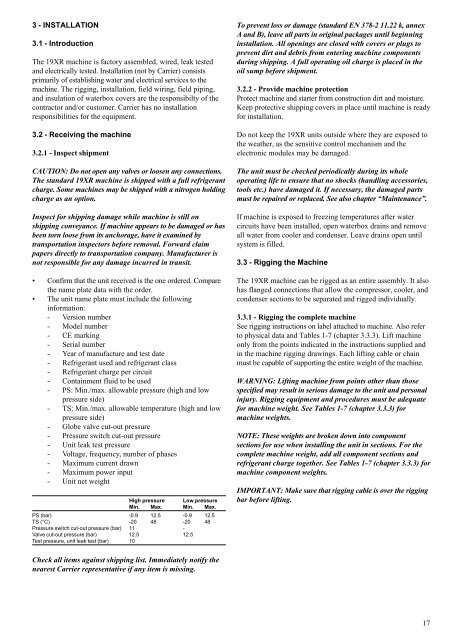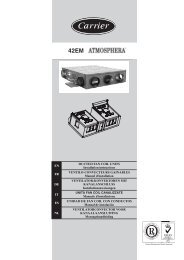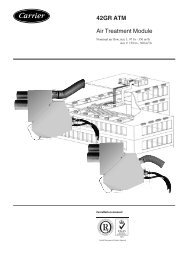19XR (PIC II) Hermetic Centrifugal Liquid Chillers 50 Hz - Carrier
19XR (PIC II) Hermetic Centrifugal Liquid Chillers 50 Hz - Carrier
19XR (PIC II) Hermetic Centrifugal Liquid Chillers 50 Hz - Carrier
Create successful ePaper yourself
Turn your PDF publications into a flip-book with our unique Google optimized e-Paper software.
3 - INSTALLATION<br />
3.1 - Introduction<br />
The <strong>19XR</strong> machine is factory assembled, wired, leak tested<br />
and electrically tested. Installation (not by <strong>Carrier</strong>) consists<br />
primarily of establishing water and electrical services to the<br />
machine. The rigging, installation, field wiring, field piping,<br />
and insulation of waterbox covers are the responsibilty of the<br />
contractor and/or customer. <strong>Carrier</strong> has no installation<br />
responsibilities for the equipment.<br />
3.2 - Receiving the machine<br />
3.2.1 - Inspect shipment<br />
CAUTION: Do not open any valves or loosen any connections.<br />
The standard <strong>19XR</strong> machine is shipped with a full refrigerant<br />
charge. Some machines may be shipped with a nitrogen holding<br />
charge as an option.<br />
Inspect for shipping damage while machine is still on<br />
shipping conveyance. If machine appears to be damaged or has<br />
been torn loose from its anchorage, have it examined by<br />
transportation inspectors before removal. Forward claim<br />
papers directly to transportation company. Manufacturer is<br />
not responsible for any damage incurred in transit.<br />
Confirm that the unit received is the one ordered. Compare<br />
the name plate data with the order.<br />
The unit name plate must include the following<br />
information:<br />
- Version number<br />
- Model number<br />
- CE marking<br />
- Serial number<br />
- Year of manufacture and test date<br />
- Refrigerant used and refrigerant class<br />
- Refrigerant charge per circuit<br />
- Containment fluid to be used<br />
- PS: Min./max. allowable pressure (high and low<br />
pressure side)<br />
- TS: Min./max. allowable temperature (high and low<br />
pressure side)<br />
- Globe valve cut-out pressure<br />
- Pressure switch cut-out pressure<br />
- Unit leak test pressure<br />
- Voltage, frequency, number of phases<br />
- Maximum current drawn<br />
- Maximum power input<br />
- Unit net weight<br />
High pressure Low pressure<br />
Min. Max. Min. Max.<br />
PS (bar) -0.9 12.5 -0.9 12.5<br />
TS (°C) -20 48 -20 48<br />
Pressure switch cut-out pressure (bar) 11 -<br />
Valve cut-out pressure (bar) 12.5 12.5<br />
Test pressure, unit leak test (bar) 10<br />
Check all items against shipping list. Immediately notify the<br />
nearest <strong>Carrier</strong> representative if any item is missing.<br />
To prevent loss or damage (standard EN 378-2 11.22 k, annex<br />
A and B), leave all parts in original packages until beginning<br />
installation. All openings are closed with covers or plugs to<br />
prevent dirt and debris from entering machine components<br />
during shipping. A full operating oil charge is placed in the<br />
oil sump before shipment.<br />
3.2.2 - Provide machine protection<br />
Protect machine and starter from construction dirt and moisture.<br />
Keep protective shipping covers in place until machine is ready<br />
for installation.<br />
Do not keep the <strong>19XR</strong> units outside where they are exposed to<br />
the weather, as the sensitive control mechanism and the<br />
electronic modules may be damaged.<br />
The unit must be checked periodically during its whole<br />
operating life to ensure that no shocks (handling accessories,<br />
tools etc.) have damaged it. If necessary, the damaged parts<br />
must be repaired or replaced. See also chapter “Maintenance”.<br />
If machine is exposed to freezing temperatures after water<br />
circuits have been installed, open waterbox drains and remove<br />
all water from cooler and condenser. Leave drains open until<br />
system is filled.<br />
3.3 - Rigging the Machine<br />
The <strong>19XR</strong> machine can be rigged as an entire assembly. It also<br />
has flanged connections that allow the compressor, cooler, and<br />
condenser sections to be separated and rigged individually.<br />
3.3.1 - Rigging the complete machine<br />
See rigging instructions on label attached to machine. Also refer<br />
to physical data and Tables 1-7 (chapter 3.3.3). Lift machine<br />
only from the points indicated in the instructions supplied and<br />
in the machine rigging drawings. Each lifting cable or chain<br />
must be capable of supporting the entire weight of the machine.<br />
WARNING: Lifting machine from points other than those<br />
specified may result in serious damage to the unit and personal<br />
injury. Rigging equipment and procedures must be adequate<br />
for machine weight. See Tables 1-7 (chapter 3.3.3) for<br />
machine weights.<br />
NOTE: These weights are broken down into component<br />
sections for use when installing the unit in sections. For the<br />
complete machine weight, add all component sections and<br />
refrigerant charge together. See Tables 1-7 (chapter 3.3.3) for<br />
machine component weights.<br />
IMPORTANT: Make sure that rigging cable is over the rigging<br />
bar before lifting.<br />
17




